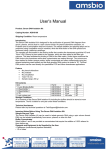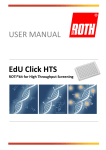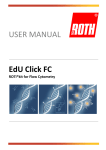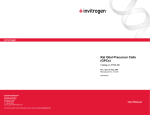Download Neural Progenitor User Manual
Transcript
Neural Progenitor User Manual TABLE OF CONTENTS Page Introduction .................................................................................................... 2 Materials Required .......................................................................................... 3 Media Storage and Handling ........................................................................... 4 Preparation of Poly-Ornithine and Laminin Coated Plates ................................ 5 Thawing Neural Progenitor Cells...................................................................... 6 Subculture of Neural Progenitor Cells.............................................................. 7 Characterization ............................................................................................. 8 Differentiation ................................................................................................. 9 Fixing Cells ................................................................................................... 10 Staining for Intra-cellular Proteins ................................................................ 11 Staining for Extra-cellular Proteins ............................................................... 14 Appendix: Figure 1 ............................................................................................... 16 Figure 2 ............................................................................................... 17 Figure 3 ............................................................................................... 18 To learn more about Aruna Biomedical, Inc. visit our website at: www.arunabiomedical.com ArunA Biomedical, Inc. www.arunabiomedical.com INTRODUCTION ENStem-ATM Human Neural Progenitor Cells Aruna Biomedical has developed a method to derive Neural Progenitors from NIH registered human embryonic stem cells (hESCs). This allows us to produce user-friendly, turn-key kits containing cryopreserved Neural Progenitors and all the reagents needed to propagate and differentiate Neural Progenitors into primary cultures of neural cells. The technical innovation is that our Neural Progenitors and their derivatives will proliferate as adherent monolayer cell cultures. As a direct result of this advance, our Neural Progenitor cell products can be reliably differentiated for quantitative studies of neurons and glial cells. Aruna’s Neural Progenitor cell products will benefit biomedical research in both neurological disorders and the basic science of human developmental pathways. Thanks to Aruna Biomedical, more researchers will have ready access to adherent monolayer human neural cells, allowing for quantitative analysis for either small scale or high throughput/content screens. We look forward to this new technology leading to the discovery of novel therapeutic compounds, tests for neurotoxicity, and breakthroughs in understanding human neural development. We also look forward to hearing your feedback on our product. For support and technical assistance, contact us at: [email protected] [email protected]. For Research Use Only; not for use in therapeutics or diagnostics ArunA Biomedical, Inc. www.arunabiomedical.com 2 MATERIALS REQUIRED • ENStem-ATM HUMAN NEURAL PROGENITOR CELLS…………...Chemicon (Part No. SCC003) http://www.millipore.com/catalogue/item/scr055 • ENStem-ATM NEURAL EXPANSION MEDIUM…………………….Chemicon (Part No. SCM004) http://www.millipore.com/catalogue/item/scm004 • ENStem-ATM NEURONAL DIFFERENTIATION MEDIUM………….Chemicon (Part No. SCM017) http://www.millipore.com/catalogue/item/scm017 • ENStem-A™ Neural Freezing Medium……………………….Chemicon (Part No. SCM011) http://www.millipore.com/catalogue/item/scm011 • POLY-L-ORNITHINE HYDROBROMIDE…………………………......Sigma (Part No. P3655) • LAMININ…………………………………………………………......Sigma (Part No. L2020) • L-GLUTAMINE………………………………………………….......Millipore (Part No. TMS-002-C) • PENICILLIN/STREPTOMYCIN SOLUTION……………………….....Millipore (Part No. TMS-AB2-C) • PHOSPHATE-BUFFERED SALINE (1X PBS)……………………….Millipore (Part No. BSS-1005-B) ArunA Biomedical, Inc. www.arunabiomedical.com 3 • MEDIA STORAGE AND HANDLING (For thawing and subculture of cells) ENStem-ATM Human Neural Expansion Medium: ENStem-ATM Neural Expansion Medium should be stored at -20°C until ready to use. Upon thawing, fresh LGlutamine should be added to the ENStem-ATM Neural Expansion Medium for a final concentration of 2 mM. FGF-2 should be added fresh to the ENStemATM Neural Expansion Medium for a final concentration of 20ng/ml before each use. Thawed medium should be stored at 2-8oC and given a 1-month expiration date. Protect from light and wide swings in temperature. Basic FGF-2: (50 µg, lyophilized) should be reconstituted with 100 µL 5 mM Tris-HCL, pH 7.6 for a final concentration of 100 µg/ml. Dispense into aliquots to avoid repeated thawing. Store at -20°C. COMPLETE NEURAL EXPANSION MEDIUM Reagent Amount per ml Amount per 100 ml ENStem-ATM Neural Expansion Medium 0.99 ml 99 ml L-Glutamine 10 µl 1 ml FGF-2 0.2 µl 20 µl ArunA Biomedical, Inc. www.arunabiomedical.com 4 PREPARATION OF POLY-ORNITHINE AND LAMININ COATED PLATES We recommend using poly-ornithine and laminin coated plates to culture Neural Progenitor cells. Poly-ornithine and laminin coated plates provide the optimal foundation for adhesion and growth. 1. Thaw the poly-ornithine and laminin slowly at 4°C. 2. Dilute poly-ornithine to 20µg/ml in cold, sterile ddi water. 3. Dispense poly-ornithine solution to completely cover the bottom of the dish (2 ml/35 mm, 5 ml/100 mm). 4. Incubate in a humidified 37°C incubator for at least 1 hour. 5. Remove the poly-ornithine solution and rinse once with sterile ddi water. 6. Dilute laminin to 5µg/ml in cold sterile ddi water. 7. Dispense laminin solution to completely cover the bottom of the dish (2 ml/35 mm, 5 ml/100mm). 8. Incubate in a humidified 37°C incubator for at least 1 hour. Transfer plates to 2-8°C and store plates in laminin solution for up to 3 weeks. 9. Store at 2-8°C for up to 3 weeks. 10. To use, bring up to room temperature (leave on bench top or place on warm plate set at 37°C). Aspirate the laminin solution and rinse one time with PBS before use. ArunA Biomedical, Inc. www.arunabiomedical.com 5 THAWING NEURAL PROGENITOR CELLS 1. All materials should be ready prior to thawing vial. 2. Cells are thawed rapidly by hand rotating the cryovial in a 37°C water bath. Note: Thaw rapidly for maximum cell viability. 3. Spray vial with 70% ethanol and dry before placing in a biological safety cabinet. 4. Working in a biological safety cabinet, transfer the thawed cells into a sterile 15 ml conical centrifuge tube. 5. Swirling slowly, drop-wise add 10 ml of pre-warmed NEURAL EXPANSION MEDIUM to the cell suspension. Warning: Adding media all at once may result in osmotic shock. 6. Centrifuge at room temperature at 200 x g for 4 minutes. 7. Carefully aspirate as much of the supernatant as possible. Note: Steps 4-6 are very important in the removal of residual DMSO. 8. Resuspend the cells in 2 ml of NEURAL EXPANSION MEDIUM. 9. Plate the cell suspension at a density of 1 vial (Approximately 1 x 106 cells) per 35 mm poly-ornithine and laminin coated tissue culture dish. 10. Incubate the cells at 37°C in a 5% CO2 humidified incubator. 11. After the cells have incubated for 24 hours, the NEURAL EXPANSION MEDIUM in the plate should be aspirated and replaced with fresh medium. Medium should be changed every other day thereafter. 12. Once the Neural Progenitor cells reach 90% - 100% confluence, they can be dissociated manually and passaged or alternatively frozen for later use. The cells should be maintained at a high density at all times and passaged at a 1:2 or 1:3 dilution. ArunA Biomedical, Inc. www.arunabiomedical.com 6 SUBCULTURE OF NEURAL PROGENITOR CELLS Note: This process does not utilize enzymatic digestion. 1. Once the Neural Progenitor cells reach 90% - 100% confluence, carefully remove the media from the poly-ornithine and laminin coated 35 mm tissue culture plate containing the Neural Progenitor cells. 2. Add pre-warmed NEURAL EXPANSION MEDIUM to the plate (2 ml/35 mm, 7 ml/100 mm) so that cells can be harvested in fresh medium. 3. The cells should then be manually passaged by pipetting up and down to manually detach them from the plate. Cells should be triturated into an almost single cell suspension prior to passaging. We recommend using a 200 µl or 1000 µl manual pipette for 1 – 2 minutes, depending on size of plate, to detach the cells. Alternatively, cells can be detached with a sterile cell scraper, and then triturated into a single cell suspension. 4. Plates should be observed to ensure that all cells have been removed. This is most easily accomplished by working under a dissection microscope within a biosafety cabinet, but can also be achieved by frequent observation under bright field or phase contrast microscopes. 5. If necessary, cells can be centrifuged at 200 x g for 4 minutes in order to resuspend the pellet at the necessary concentration. 6. Cells can now be plated at the appropriate density onto a coated plate or frozen. We recommend culturing the cells at a high density by passaging 1:2 – 1:3. 7. Replace the media with fresh, pre-warmed NEURAL EXPANSION MEDIUM 24 hours later and every other day therafter. ArunA Biomedical, Inc. www.arunabiomedical.com 7 CHARACTERIZATION Every lot of Aruna Biomedical Neural Progenitor cells has been tested for high expression levels of Nestin and Sox-2, and low expression levels of Oct-4. ENSTem-A™ Neural Progenitor Cells have the ability to differentiate into multiple neuronal phenotypes and maintain a normal karyotype after multiple passages. Cells have also been confirmed to be negative for mycoplasma. Please refer to figures 1, 2 and 3 for sample images. ArunA Biomedical, Inc. www.arunabiomedical.com 8 DIFFERENTIATION The differentiation protocol/media provided is intended as a basal system. For specific cell types, differentiation protocols including additional neurotropic factors can be developed as determined by the end user’s interests. Note: There may be considerable cell death throughout this procedure. 1. Begin the differentiation process by first removing the NEURAL EXPANSION MEDIUM. 2. Wash the plate with PBS containing Ca++ and Mg++. 3. Add pre-warmed NEURONAL DIFFERENTIATION MEDIUM to the plate (2 ml/35 mm, 7 ml/100 mm). 4. Incubate in a humidified 37°C incubator with 5% CO2. 5. After 2 to 3 days when the plate is confluent, passage the plate 1:2 in NEURONAL DIFFERENTIATION MEDIUM following the subculturing protocol. 6. Incubate in a humidified 37°C incubator with 5% CO2. 7. Replace media with fresh, pre-warmed NEURONAL DIFFERENTIATION MEDIUM every 3 – 4 days. 8. After the desired differentiation period (cells will begin to increase expression of the neuronal marker β-tubulin within 1 week, and will have a high percentage of β-tubulin expression by the second week), cells can be harvested Neuronal Differentiation Medium and replated on a poly-ornithine and laminin coated chamber slide (we recommend 50,000150,000 cells/300 µl/well) for staining. ArunA Biomedical, Inc. www.arunabiomedical.com 9 FIXING CELLS WITH PARAFORMALDEHYDE SOLUTION PREPARATION 2% PARAFORMALDEHYDE (PFA) Reagent Vendor Catalog Number Amount per 100 ml Final Concentration Paraformaldehyde J.T. Baker S898-07 2 grams 2% PBS Chemicon BSS-1005-B 100 ml (with Ca++ and Mg++) Additional supplies include: Whatman filter paper – 42 Cat. # 1442125 Note: Paraformaldehyde is toxic, see MSDS. 1. Heat 75 ml of PBS to 56°C. 2. Add 2 grams of paraformaldehyde to the solution. Add 2 drops of 1M NaOH from a transfer pipette. 3. Once in solution use pH meter or pH paper and adjust the pH (using HCl or NaOH) to 7.4. 4. Filter using Whatman filter paper. Using PBS, adjust volume up to 100 ml. 5. Store at 2-8°C and use within 1 week. FIXING CELLS 1. Carefully remove spent media with a pipetteman or transfer pipette being careful not to dislodge cells. 2. Wash cells 1 time in PBS with Ca++ and Mg++ (PBS++). 3. Working in a fume hood, add PFA solution to cover the bottom of slide wells (250 µL/well). 4. Incubate at room temperature for 15-20 min. 5. Wash cells 3 times with PBS++. 6. Store fixed cells with PBS++ at 2-8°C until ready to stain. We recommend staining as soon as possible after fixation, preferably in the same day. ArunA Biomedical, Inc. www.arunabiomedical.com 10 STAINING FOR INTRA-CELLULAR PROTEINS SOLUTION PREPARATION HIGH SALT BUFFER Reagent Vendor Catalog Number Amount per L Final Concentration Sodium Chloride Sigma S7653 14.61 g 250mM 1M Tris (pH 7.4) Sigma T-3253 50 ml 50mM Water • • • • 950 ml Mix by inversion until completely in solution. Store at room temperature for up to 2 months. Used to make Blocking Solution and Permeabilization Buffer as well as in step 8. BLOCKING SOLUTION Reagent Amount per 10 ml High salt buffer 9.4 ml 6% serum from the animal that your secondary antibody is produced in 600 µl Mix by inversion. Make fresh Blocking Solution for each use. Used in steps 4, 5, 6, and 9. PERMEABILIZATION BUFFER Reagent Vendor Catalog Number High Salt Buffer Tween 20 • • Amount per 50 ml 50 ml EMD Chemicals 9480 25 µl Mix by inversion until completely in solution. Store at room temperature for no longer than 2 months. Used in step 3. ArunA Biomedical, Inc. www.arunabiomedical.com 11 STAINING FOR INTRA-CELLULAR PROTEINS Pre-made solutions you will need: Reagent Vendor Catalog Number PBS Chemicon BSS-1005-B DAPI VWR 80051-386 Prolong Gold Invitrogen P36930 (with Ca++ and Mg++) 1. Required for Steps 2, 12 and 15 Steps 13 and 14 Step 19 Fix cells according to protocol. All manipulations should be carried out with extreme care as cells may dislodge easily. We recommend adding and removing liquids slowly with a manual pipetteman or transfer pipette. 2. Wash wells 2 times in Ca++ and Mg++. Note: For all washes, wells should be completely filled with solution. 3. Wash with PERMEABLIZATION BUFFER 3 times for 5 minutes each. In this step you are permeablizing your cells so time is very important. 4. Add enough BLOCKING SOLUTION to completely cover the cells in each well (we recommend 250 µl/well). Incubate at room temperature for at least 45 minutes. 5. Prepare primary antibody (1° Ab) in 1 ml of BLOCKING SOLUTION at the recommended dilution. 6. Aspirate BLOCKING SOLUTION out of slide wells. 7. Add enough 1° Ab solution (made in step 5) to completely cover the cells in each well (250 µl/well). Cover and incubate 1 hour at room temperature. This can be extended to over night at 4°C if necessary. 8. Wash wells 4 times in HIGH SALT BUFFER for 5 minutes each wash. 9. Prepare secondary antibody (2° Ab) in 1 ml of BLOCKING SOLUTION at recommended dilution while completing washes in step 8. 10. Aspirate last wash. ArunA Biomedical, Inc. www.arunabiomedical.com 12 11. Add enough 2° Ab solution (made in step 9) to completely cover the cells in each well (250 µl/well). Incubate 1 hour at room temperature. During incubation, protect sample from light to prevent fluorescence bleaching. 12. Wash cells 3 times in PBS++. 13. While completing washes in step 10, prepare DAPI SOLUTION at a 1:10,000 dilution in distilled H2O. 14. Add enough DAPI to solution to completely cover the cells in each well (250 µl/well). Incubate for 5 minutes at room temperature. Protect from light during incubation. 15. Wash cells 3 times in PBS++. 16. Aspirate off PBS++. 17. Gently remove sides of chamber. 18. Tilt slide to one side and allow excess PBS++ to run off onto paper towel. 19. Place one drop of mounting media directly in center of each well area. We recommend INVITROGEN’S PROLONG GOLD. 20. At an angle gently lower a cover slip onto the slide trying to avoid air bubbles where possible. 21. Remove excess mounting media from slide and cure in the dark for 24 hours. 22. Seal with nail varnish on all four sides. 23. Keep in dark storage until results are observed and documented. ArunA Biomedical, Inc. www.arunabiomedical.com 13 STAINING FOR EXTRA-CELLULAR PROTEINS SOLUTION PREPARATION BLOCKING SOLUTION Reagent Vendor Catalog Number Amount per 10 ml PBS Chemicon BSS-1005-B 9.4 ml (with Ca++ and Mg++) 6% serum from the animal that your secondary antibody is produced in. • • 600 µl Mix by inversion. Make fresh Blocking Solution for each use. Used in steps 3,4,5 and 8 STAINING FOR EXTRA-CELLULAR PROTEINS Pre-made solutions you will need: Reagent Vendor Catalog Number PBS Chemicon BSS-1005-B DAPI VWR 80051-386 Prolong Gold Invitrogen P36930 (with Ca++ and Mg++) 1. Required for Steps 2,12 and 15 Steps 13 and 14 Step 19 Fix cells according to protocol. All manipulations should be carried out with extreme care as cells may dislodge easily. We recommend adding and removing liquids slowly with a manual pipetteman or transfer pipette. 2. Wash wells 2 times in PBS with Mg++ and Ca++ (PBS++). Note: For all washes wells should be completely filled with solution. 3. Add enough BLOCKING SOLUTION to completely cover the cells in each well (we recommend 250 µl/well). Incubate at room temperature for at least 45 minutes. 4. Prepare primary antibody (1° Ab) in 1 ml of BLOCKING SOLUTION at the recommended dilution. ArunA Biomedical, Inc. www.arunabiomedical.com 14 5. Aspirate BLOCKING SOLUTION out of slide wells. 6. Add enough 1° Ab solution (made in step 4) to completely cover the cells in each well (250 µl/well). Cover and incubate 1 hour at room temperature. This can be extended to over night at 2-8°C if necessary. 7. Wash wells 4 times in PBS++ for 5 minutes each wash. 8. Prepare secondary antibody (2° Ab) in 1 ml of BLOCKING SOLUTION at recommended dilution while completing washes in step 7. 9. Aspirate off last wash. 10. Add enough 2° Ab solution (made in step 8) to completely cover the cells in each well (250 µl/well). Incubate 1 hour at room temperature. During incubation, protect sample from light to prevent fluorescence bleaching. 11. Wash cells 3 times with PBS++. 12. While completing washes in step 11, prepare DAPI SOLUTION at a 1:10,000 dilution in distilled H2O. 13. Add 250 µl of DAPI SOLUTION to each well. Incubate for 5 minutes at room temperature. Cover with foil during incubation. 14. Wash cells 3 times in PBS++. 15. Aspirate off PBS++. 16. Gently remove sides of chamber. 17. Tilt slide to one side and allow excess PBS++ to run off onto paper towel. 18. Place one drop of mounting media directly in center of each well area. We recommend INVITROGEN’S PROLONG GOLD. 19. At an angle gently lower a cover slip onto the slide trying to avoid air bubbles where possible. 20. Remove excess mounting media from slide and cure in the dark for 24 hours. 21. Seal with nail polish on all four sides. 22. Keep in dark storage until results are observed and documented. ArunA Biomedical, Inc. www.arunabiomedical.com 15 CHARACTERIZATION OF ENStem-ATM HUMAN NEURAL PROGENITOR CELLS Figure 1. ENStem-ATM Human Neural Progenitor Cells (Part. No. SCC003) are grown as monolayers (A), are karyotypically normal (B) and express NSC markers, Nestin (C, D, green; Part No. MAB5326, 1:500) and Sox-2 (C, E, green; Part No. AB5603, 1:1000). Nuclei of the cells were visualized with DAPI (blue). The Sox-2 transcription factor is co-localized with the DAPI (blue) staining in the nucleus (F). ArunA Biomedical, Inc. www.arunabiomedical.com 16 Figure 2. ENStem-ATM Human Neural Progenitor Cells (Part No. SCC003) are negative for Oct-4 staining (A, B) while control H9 human embryonic stem cells are positive for Oct-4 staining (C; Part No. MAB4401). Mouse feeder cells are also negative for Oct-4 staining (arrows). ArunA Biomedical, Inc. www.arunabiomedical.com 17 Figure 3. ENStem-ATM Human Neural Progenitor Cells can differentiate into multiple neuronal subtypes. Using ENStem-ATM Neuronal Differentiation Medium (Part No. SCM017), a majority of the cells exhibit a neuronal phenotype (A, III-tubulin, red; Part No. MAB1637, 1:1000). Cultures contain some GABAergic (C, GABA, red,) cells that express the transcription factor HB9 (D; Part No. AB5963, 1:50) and also cholinergic cells (E, ChAT, green; Part No. AB144P, 1:100). GABAergic cells colabel with the neuronal marker III-tubulin (B, D). Cell nuclei were visualized with DAPI (blue). ArunA Biomedical, Inc. www.arunabiomedical.com 18




























